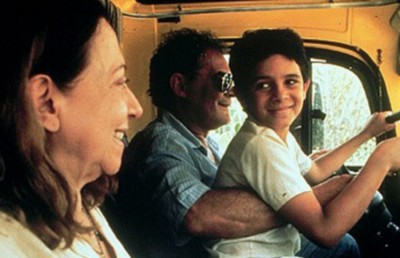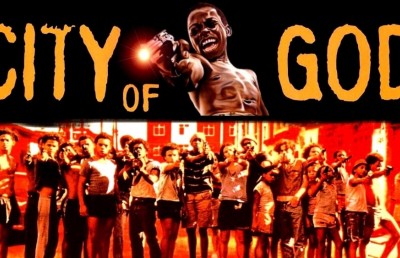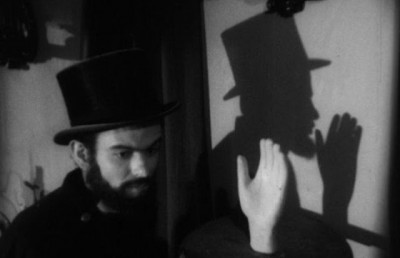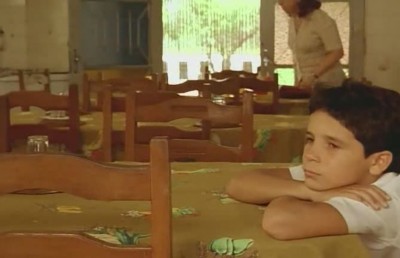Jose Mojica Marins: Up-Close and Personal
Talking with Coffin Joe
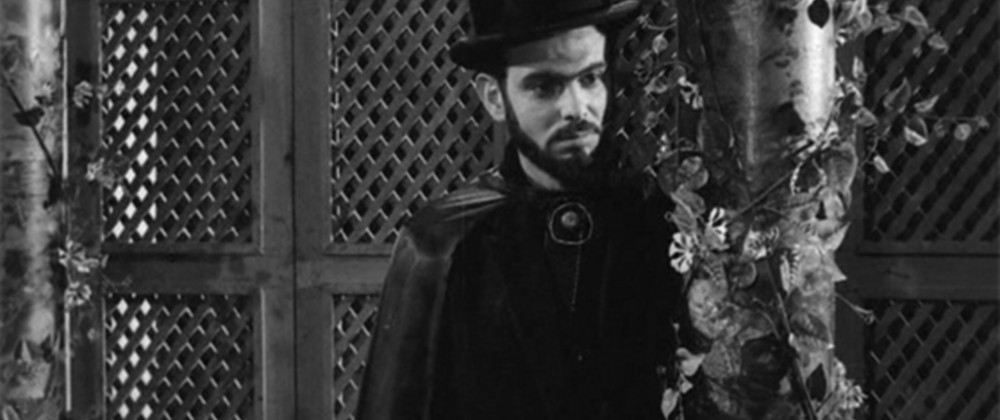
The man is Jose Mojica Marins, the alias is the sadistic, nihilistic undertaker Coffin Joe, or Zé do Caixão in Portuguese. Marins has had a fascinating life and career, beginning as a youngster making super 8mm films, and growing up through a series of tumultuous political periods in Brazil, where he made the country’s first horror film, and struggled through governmental censorship and the stigma of being a lone horror filmmaker to become one of Brazil’s most visible and widespread (comics, television, film, song, etc.) popular artists. Marins’ Coffin Joe is one of the most vile, strong headed and antagonistic characters seen in any cinema, and yet he became a hero of sorts for the poor and underprivileged, to the point where he even flirted with politics and social reform. What is fascinating about the persona of Coffin Joe (Zé do Caixão) is that even though he has the negative traits of an anti-hero, or a villain, he becomes the focal point for viewers because there are no other characters in his films that remotely fit the bill of hero or heroine. While an ‘anti-hero’ on the one hand, Coffin Joe is also a whipping boy, a stand-in for all of those negative aspects of Brazilian patriarchy and politics; and a cathartic release of repressed social anger against the establishment, the church, the authority, the police, and so on. An autodidact, Marins’ films are at once primal and primitive, yet paradoxically contain an intellectual subtext with echoes of Friedrich Nietzsche —his ‘will to power,’ ‘Overman,’ and proclamation “God is dead”— and the Marquis de Sade (his theories on sexuality and human nature) for anyone willing to read into his alias’ twisted philosophy. This interview was conducted several years ago, in the summer of 2001, when Marins was an invited guest of the Fantasia film festival. It has taken a while for the timing to be right, but Offscreen is pleased to finally present what we feel is the most in-depth interview with Marins in the English language. (Donato Totaro)
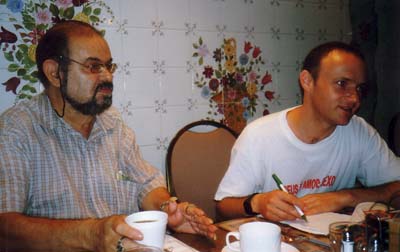
Offscreen: A question in terms of your birth date because according to the sources I have seen 1929 and 1936.
Jose Mojica Marins: The correct date is 13.03.1936. Friday 13, to follow the superstition. There are a lot of superstitions in Brazil.
Offscreen: You have to excuse me for the error that’s in the book [1] then, I have it as 1929. I made you seven years older. Sorry! Maybe we will start with a simple question: I know you are self-taught and self-educated, and were illiterate at one point, but you have many philosophical ideas in your films. I am wondering where these ideas came from, if is not from books?
Jose Mojica Marins: Basically, I am an autodidact. As a kid, I had a precocious childhood. As an eight or nine year old child I could not keep a conversation with other children my age. They had to be fifteen or sixteen years or older to understand me.
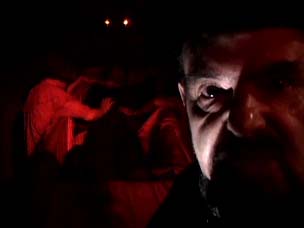
My father was bullfighter and my mother used to be a Tango dancer and a Tango singer. She used to dance Spanish and Argentinean styles as well. I was the only child in my family. In between the age of two and three years, my father used to travel a lot all over Brazil. My mother didn’t like such a nomadic life and dreamed of a fixed residency. One of my father’s cousin used to own a theatre in a Sao Paulo, then my father moved over there, where he became the manager of the theatre. Meanwhile we started to live in the back of the theatre. Therefore, since the age of three, I just saw films. I was growing up and experiencing cinema, watching many films.
I was touched by Charles Chaplin’s films. Everybody would laugh at his films, however I would not, because I would get tormented seeing the anguish in Chaplin’s eyes. It always touched me so much. It is important to emphasize that the first impact that cinema provoked on my life was when I could get access to behind the cinema screen, and the projectionist booth. There was a screening about sexually transmitted diseases. At that time, Tuesdays would be the screening day for women and Thursdays for men. When I saw the images I was impressed. It was shocking seeing the STD images. I was between three and four years of age. I was shocked.
At six years old, there was a potato seller who lived in my neighborhood. He used to sell potatoes using a wagon, but he used to be a storyteller. Everybody loved him. He would tell stories about speaking with the animals in paradise and so on. One day, the potato seller died. The city was so quiet. Everybody was mourning. It was considered a holiday. The police chief, priests, businessmen and everybody else was at the wake. I went with three of my friends. The mother of the dead person was shouting, “Why do just the good people go away instead the bad people? The wife was saying: “Why was it not me instead of him.” I was just watching and soon after, his son began praying in order to bring their father back to life. Everybody began praying, me too. A minute after, the potato seller began moving his hands. He rose from the coffin and sat up. Everybody left the room. People were waiting across the street. The four of us thought that our praying brought him back to life. There he was with cotton in his nose, he must have been wondering what was going on, where he was. In fact he did not die, but had catalepsy. Nobody knew catalepsy at that time. It was around the 1940’s. After that his wife asked for a divorce alleging that he was not her husband. His mother denied he was his son, declaring him to be the devil. Nobody would buy his potatoes anymore. He was forced to move to another neighborhood. It was impossible for him to establish himself in the new neighborhood because of the gossip that was spread. Solitude drove him to madness and he ended up in psychiatric hospital. Two years later he died. This happening had a profound impact in my life. Why do people ask for the dead to come back to life and then are afraid when they return?
After that, when I was about ten years old, instead of asking for a bike, I asked my father for a movie camera. It was not even 16mm but 8.5 mm. I had a Catholic upbringing. At the age of ten I used to be a fellow of Mary (Pious Union of the Daughters of Mary Immaculate). The church referred a lot to ‘Judgment Day‘. Since I was an avid fan of cartoons with spacecrafts, such as Flash Gordon and Buck Rogers in the 30th Century [translator note: Buck Rogers in the 25th Century], I thought about making a film about “Judgment Day.” I thought that such a film would suit the church’s taste. They would like it. Since I used to live in the theatre and my father was the manager, it was easy for me to offer each individual a free ticket to the theatre in exchange for 1 kg of food. People brought bags and bags of food.
I made the film. But I wondered, why a spacecraft instead of a coffin, which must be a human’s best friend, since this is where all humans will lay when they die? This was the script: There was a city where extraterrestrial beings would come in a coffin craft. The craft had a lantern that would direct its light onto the good people and make them disappear. For example, if they were in a club dancing, the good people would disappear and the other people would be frozen. The same would happen if they were at a dinner, for example; sometimes the father would be taken out with his son while the mother would be left frozen. The ones that were left frozen decayed and were transformed into worms.
Offscreen: Is this something that you had done as a comic book?
Jose Mojica Marins: No, It’s a 8.5mm film shot when I was ten years old. The final moments of the film would show the spring of the green on the earth’s surface with flowers springing up. In the middle of the flowers, lots of children appeared, which was for me the best way to represent “judgment day.” I showed the film to my father who was so proud. He insisted on inviting the priest for a private screening. Since it was a silent movie, my father played some sacred music on vinyl. The priest was astonished; instead of compliments he approached my father saying: “your son is a mentally disturbed person,” and the priest advised my father, “you must bring him to be treated by a specialist.”
At that point I dedicated myself to cinema. From 8.5mm I switched to working with 16mm. I learned by making films, through direct experience since there was nobody to teach me. An amateur way of doing film. Recently one of my films shot in 1948 was found. Someone brought the film to the Brazilian Cinemateca (Brazilian Film Board and Archive). It is called Reino Sangrento (Bloody Kingdom). It is a short where two youngsters think that the Amazon Forest is the center of the universe. They decide to explore the forest. There is a little accident, and they ended up fainting. After recovering, they wake up surrounded by Arabian people and all the Greek mythological Gods, like Apollo and Atlas. I was part of the cast as an Arabian sultan who seeks the king’s power. The wardrobe came from a costume store specialized in renting material for the carnival. I was 13 years old. I announced the shooting in the newspaper’s classified ad, inviting people to be part of the cast. More than 200 people showed up for the shooting. Since that film was only recently discovered, there is no information about it in Andre Barcinski’s documentary (Maldito – O Estranho Mundo de José Mojica Marins??/ ??Coffin Joe: The Strange World of José Mojica Marins, 2001). He will mention it in a future edition.
I am still looking for other works more experimental in nature. I made about 30 to 35 films in different formats before I attempted my first feature film in 1953. It is called A Sentença de Deus (God’s Sentence). In fact this is a film that I never finished since there was the death of an actress in the “Vera Cruz” Studios, she drowned while taking a bath. There was a lot of material shot for that film; however, there were several tragedies surrounding it. I mentioned the first actress that drowned; outside the film, a second actress was sick with tuberculosis and died later. I am planning to collect all these excerpts and produce a documentary where I will narrate the reasons that made it impossible to finish the film.
I was the pioneer in releasing comics in a photo story format in Brazil. I did it in order to survive. Meanwhile I was teaching dramatics and theatre to amateurs. Following that I made my first [extant, ed.] feature film, also the first Cinemascope film produced in Brazil, called A Sina do Aventureiro (Way of the Adventurer, 1959). It was in a rural western style, which is called “Bang-Bang” in Brazil. In one of the scenes, everybody was in a waterfall in the province of Minas Gerais, swimming naked, men and women. I used this scenario in order to put the two actresses taking a bath together. Then the lead actor falls in the lake. The actresses went to help him out. They were naked, however there was 500 meters distance between the camera and the set, moreover, with a lawn in between. The film was condemned by the priests and by the church because of its nudity. Throughout Brazil, during the Sunday mass, the church would ask its members to avoid and boycott Mojica’s film.
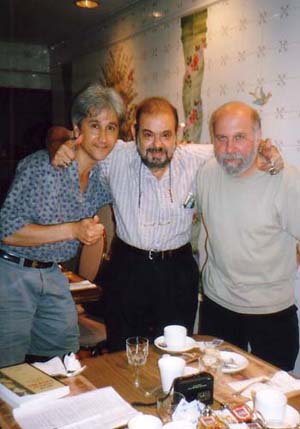
Offscreen: We are getting incredible stories, but it seems that this early work is really relevant for the third phase of “Cinema Nõvo,” the Tropicalist phase and also Magic Realism, and also the magical side of Latin American culture. It sounds like this work is really important.
Jose Mojica Marins: In the beginning I was considered on the marginalia of Brazilian cinema in Portuguese: “Cinema Marginal.” But going back to my revolt against the priests [the church], in 1961 there was a Cinema School called “Escola Superior de Cinema,” in Sao Paulo; it was directed by the priests. I approached them asking them for the reason why the church does not support my works, my cinema. He then suggested that I produce a tape showing the good side of the church, for example showing priests helping children and so on. Then I made a musical called Meu Destino em Tuas Mãos (My Fate Is In Your Hands, 1961) where five children, because of similar circumstances, leave their home for adventure in the streets, until being helped by the priests. These kids went through several adventures and they were helped by the priest to be integrated into the family. The film ends on Christmas Eve with everybody celebrating. I screened the film for the church and they clapped and gave it a standing ovation. However I tried to have the film shown but it was rejected. I asked the priest about the rejection and he told me that I should not try to make films, that I am not a filmmaker. In order to show the film, I had to rent the theatre with the assurance of filling it half to capacity. Then in 1963 I made a film about the behavioral change of the youth, including rock n’ roll, drugs, the influence of Elvis Presley, to summarize a ‘rebellious youth without a cause.’ The production of that film caused a lot of polemics. I found partners and sponsors interested in producing the film. In a meeting with them, I presented a synopsis of the film, but it was rejected. However, it was through a nightmare that I had which led to the creation of “Coffin Joe.”
I wanted to produce Coffin Joe’s film. My father had saved some money in the bank and owned a car. I owned a house that I was building myself. So I sold all those items plus all my appliances. My wife went to live with her parents. I was left with almost nothing, but I decide to produce the film by myself. I hired the best technical team available from “Vera Cruz,” the most important Brazilian film studio. Those technicians were not quite comfortable working in my studio, since it was too small compared with the one that they were used to working in. Their requirement: daily payment. Then the difficulties became more real. I could not find an actor to play Coffin Joe. Nobody wants to be ridiculed. There was an actor that accepted to play Coffin Joe, who turned it down just minutes before the recording. He sent a letter saying that the TV did not allow him to be part of the cast. It was a made up story, he was lying. In truth he was ashamed.
In the studios, there was a janitor who was quite involved in voodoo. He had used the space to do some voodoo ceremony and a black cape was left behind. I also saw an empty package of cigarettes called “Classico” whose character’s picture shows him using a top hat and a cape. I rented a top hat. I got my old black suit and bought a new black shirt, plus the cape, and as a result, I played Coffin Joe by myself. At that time I was used to leaving my thumbnail long without trimming it. I listened to my make-up technician, who suggested that I must use artificial nails in order to make it longer. At that time I was sporting a beard. My family had wanted me to keep my beard in devotion to the saints, so that helped me towards the formation of the character. Since during my nightmare I could not see Coffin Joe’s face, I assumed that he would be bearded. In October 15, 1963 I began the first shots and Coffin Joe was born.
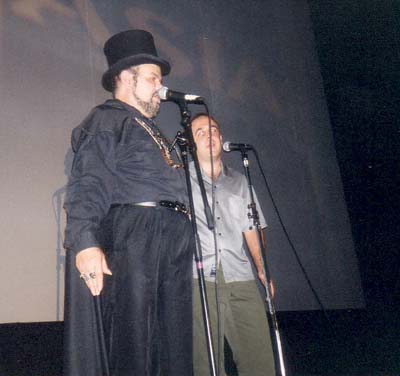
Offscreen: Sao Paulo was the center, the high profile of the Brazilian filmmaking. Cinema Nõvo was more developed in Rio de Janeiro and the Brazilian Northeast. In Sao Paulo they make very conservative kinds of films. So it sounds to me like you would fit in very well with the likes of Glauber Rocha, and so on. Rocha had said at one point that Marins was one of the greatest filmmakers. You mention that Cinema Nõvo never helped you, but did you in fact know Glauber Rocha in those days?
Jose Mojica Marins: Well yes, maybe because of Sao Paulo, and its conservativism, I was left in the marginalia. When Glauber Rocha saw my film At Midnight I’ll Take Your Soul, he was astonished, he said that the film is one of a kind. As were Luís Sérgio Person, Anselmo Duarte and so on. There was a division about my work. Half would support it and the other half would not. That is why I became a polemical filmmaker. Glauber invited me to a meeting in Rio de Janeiro with the Cinema Nõvo troupe, such as Cacá Diegues and so on. He asked me to explain to them the reason why my films were profitable and sellable while their films were not. I explained that the viewer does not want a puzzle. You can show the message that will be discussed and discovered by the intellectual but you must show good visuals since that is what the cinemagoer pays for. Since then, most of them began to follow my example in producing commercial films. For example Cacá Diegues. Their productions were quite individualist. They produced just for themselves.
Gustavo Dahl, who was once the Embrafilme’s director, gave me a book about cinema, since I had never read anything about cinema (Embrafilme was Brazil’s first government film agency, established in 1969, ed.). I did not know anything about cinema. When Luís Sérgio Person saw the book, he tore the book apart saying that I must not read anything about cinema. You must follow your own way of making film. He ended up as an actor in The Strange World of Coffin Joe, 1967. Then there was the military dictatorship, and the polemic became bigger. I became persecuted by the dictatorship and the censorship. Even though I had so many people supporting me, there were so many that did not. Today, after so many years, the very same people that once classified my films as “Trash,” recognize its intellectual value. I read once in a Brazilian magazine called Close-up something really fascinating, demonstrating the incoherence of the critics. At that time I was hired to produce a film in a “Pornochanchada” style, a film meanwhile comic and erotic however not too explicit. It was a large budget film. I used the name of J. Avelar as a pseudonym for that film. The magazine published an article in which the critic-journalist emphasized J. Avelar as a potential master of the cinema, a great director. In the same issue there was a critical article about the film The Bloody Exorcism-O Exorcismo Negro (1974) by Jose Mojica Marins.
Offscreen: I want to discuss some of the contradictions around Coffin Joe’s character. For example, Coffin Joe says he was married five times, to show us that he loves women, yet he is sexist. He believes that women should be submissive which is part of the Catholic belief, something that is in the bible, yet Coffin Joe is very strongly anti-Catholic. Coffin Joe says he believes in God and nothing else, but in his films you get the sense that there isn’t the real strong belief necessarily in God. It makes me think of Luis Buñuel who said, “I am an atheist, thank God.” And in your work there is clearly always a struggle around this Catholic upbringing.
Jose Mojica Marins: This is an influence from the European tradition, Catholicism. The two characters Coffin Joe and Jose Mojica Marins, are separated entities. The character of Coffin Joe suffers from disillusion because of a broken love. He was engaged with a girl who was not able to communicate with him, since he was in the war. The girl ended up having a relationship with the city’s mayor. When Coffin Joe came back from the war, the city was celebrating the return of the soldiers. The experience in the war led to traumas that gave him hallucinations. The deaths that he saw impressed and traumatized him. When Coffin Joe came back, he was expecting to see his fiancée waiting for him. However when he got there, there was nobody waiting for him. For someone who wanted to get away from his situation of a neglected funerary man, son of a mortician, facing so much discrimination, for him that was a disgrace. Coffin Joe met a drunk person on the street and asked where the people were. He said they were in the Cultural Center celebrating the end of the war. When he arrived at the celebration he saw his fiancée on the lap of the mayor. He killed both of them. He was freed from jail since the act was considered to be caused by war neurosis. Obviously all of these events shocked him so much. The woman who he considered the most serious amongst all women in the world betrayed him. That caused him to lose the capacity for love. From then now, he wished to find a woman that would be faithful and submissive. He did not develop the feeling of hate. His thought was developed around the idea that it does not matter if ten, twenty, or even a hundred inferior people die if he would be saving 6 billion of people.
Offscreen: Is he a kind of Antonio das Mortes, from Glauber Rocha’s film?
Jose Mojica Marins: The meeting between Antonio das Mortes and Coffin Joe was Glauber Rocha’s dream. An unrealized film because of Glauber’s death. Unfortunately the actor who played Antonio das Mortes is also dead, therefore the meeting is impossible.
I always enjoyed Glauber’s daring behavior. Not exactly in his cinema, but in his eloquent TV interviews where he spoke openly, criticizing everybody who needed to be criticized; as well in the articles written by him and interviews. But his cinema was too intellectualized in my point of view. Glauber once proposed to make a feature. The same script directed by three different directors. The script was written by Janio Quadros’s cousin (translator note: Janio Quadros is a former controversial Brazilian president). She was in exile and ended up coming back to Brazil. She wrote O Comboio da Morte (The Train of Death). The same story would be split in 30 minutes each. It was myself, Lima Barreto, the director of O Cangaceiro, and Glauber Rocha. However, Glauber and Lima Barreto were in disagreement. On my side, I found a producer for the part of the film. Each one would choose his crew and cast for the film. I spent eight months to convince Lima Barreto to direct his part of the film and getting Glauber and Lima Barreto to be friends again. When we cleared the grounds to start the film, Glauber Rocha passed away.
The general subjects for the film were as follows: One featured an intellectual, like Glauber and his style. There was the cabocla of Lima Barreto (translator note: a cabocla is a mestizo woman, a common character in Barreto’s films). Finally, myself with my ordinary people’s history. The spectator would see the same plot from each director’s point of view. I went ahead with Lima to produce our share of the film. When I convinced the producer to finance the film, Lima Barreto also passed away. Then I went on making my own cinema, the way that I wanted to.
I will go back to the problem of “woman’s submission” which we mentioned early. Otherwise you will think that I am avoiding the subject. You want to know why Coffin Joe makes women submissive to him. After his disappointment with his fiancée (and women), Coffin Joe was seeking a woman to give him a baby. As you can see in the film, the chosen woman would rather die than have the baby, since both were at risk (At Midnight I’ll Take Your Soul). Coffin Joe believes in the hereditary of the bloodline. If the woman thinks as he does, his baby will be born like them. In reality, he wants to bring down the system and its demagogy. He is against lies. He wants to begin a world without prejudices. Prejudices that he himself suffered in being a son of a mortician. His will is that people, black, yellow and so on open themselves up to communication peacefully. That they carry on as normal human beings. In his mind, by having a baby that inherits his thoughts and feelings, the future generation will also carry it on.
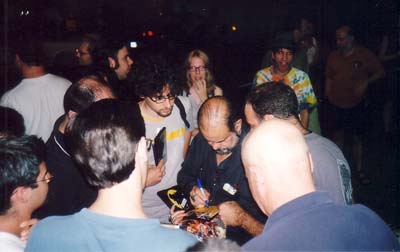
Offscreen: Just related to that, there is a question that I want to ask. The discussion of marrying a perfect woman and having a perfect child, a superior child. A child who is not corrupted by ignorance. This sounds, to someone who may not know, like the master race, the Nietzschean ‘superman’ or ‘Overman,’ or even the Nazis. Was that intentional to make him a negative character or was it just a coincidence that there are such similarities?
Jose Mojica Marins: NO, NO – Hitler wanted the superior race but in a material perspective. Human race was in his view subjected to his aesthetics. Black people, yellow and so on were discriminated against. Coffin Joe did not have an appealing physical beauty. For him the essence of the being is more important.
Offscreen: Does he state that in the film? Because what I remember him saying is more related to stupidity and ignorance. People are stupid because they are superstitious, because they believe in the devil and the forces of evil.
Jose Mojica Marins: Through Coffin Joe all of this will be filtered. His fight is to change the system. It is proven, according to a survey, that in the world’s population, 90% of people are ugly (it was shown once on Globo TV) and 10% are beautiful. Coffin Joe sees it in that way. Since 10% of people are beautiful, they crush the ugly people because they are too ugly. Now, if you invert it. Take for example an island where you leave just the ugly children. On that island, all the people displayed will be the ugly ones. All the films that they would be watching too will be cast with just ugly people. If one day one of those children sees a beautiful person, he/she will think they are ugly. They would be so sorry for them and they will be just 10% of the population. A good reversed situation.
Offscreen: We would like to talk about your visual style and relationship with cinematographer Giorgi Attili.
Jose Mojica Marins: Giorgio Attili, director of photography, made around 15 films with me. I never used a storyboard. The process was mostly in talking to my DOP about my needs and ideas. I did not even know the technical terms used in cinema such as close-up, American plan and so on. My crew understood my way of work. In the beginning Attili did not believe that was possible. In the way I see the cinema made by others, I think that too much time and money is spent in discussion and filming two, three, or four times. I will film just one time, in one take. I go back to film again only if there was a technical problem.
Offscreen: Related to that, the scene with the tarantulas in This Night I’ll Possess Your Corpse. Did you have just one camera for that?
Jose Mojica Marins: I always used just one camera in my productions.This year, I was invited by Globo TV, one of the major TV stations in Brazil, to produce a short for TV. The short film was called Pacto Nervoso (A Nervous Pact). Globo offered me four cameras and I just asked for one camera. The cast of Globo enjoyed working with me. Their comments were: that is a real cinema. We breath cinema.
In Brazil, the money is always distributed according to the interest of the politicians, to first benefit their own relatives. There is always a personal interest behind the allocation of resources, favoring their brothers, or either a cousin or a friend and so on. Politics is still dictating how the resources are distributed.
Offscreen: The fact that you have been recognized abroad since 1990, in terms of the release of your films on video and the Fantamos DVD releases, has that changed the perception of you in Brazil and has it helped you in getting funding?
Jose Mojica Marins: I think I contributed a lot to Brazilian cinema. In the past people would ask me how I made my films without money. I explained that first I use my own resources, if there is no more then I would go after financing it in other ways. My way of financing my film is in the form of cooperative. I was the pioneer in using the system of coop to produce films. After the collapses of Vera Cruz, Maristela and Multifilms, it seemed that it was the end of Brazilian cinema. There was no way to produce more films. It went that way until the government began to fund cinema productions. That was the moment that the independent filmmakers began to appear. Rogerio Sganzerla, O Bandido da Luz Vermelha, (The Red Light Bandit), Ozualdo Candeias, A Margem (On The Edge), Reichenbach, all used the system of cooperative. Today, if there is no governmental help, I will go back to the cooperative way to produce my films.
Offscreen: Financially are you better off now?
Jose Mojica Marins: Before I die, my dream is to make a film where I will not need to beg my friends to help me out. I do not want to ask my technicians and cast to reduce their fees. I want to produce a film with enough money to pay my crew decently. I want to pay my crew what they deserve. That is my dream before I die. It will be my satisfaction. Throughout my life, I have been always supported by technicians, crew members and the cast that work with me. So I would love to pay them back.
I do not receive any pension from the government. I am 65, turning 66 years old. I believe that I am going to survive through my body of work. My work has been released abroad and I have been recognized world wide
Offscreen: Hearing about the background, you know, the strange mixture of living in a theatre, making films behind a church, making comic books and super-8 films based on dreams, if you look at the Awakening of The Beast, this vision all makes sense. People compare you to Alejandro Jodorowsky, but actually, I think your works are more cinematic than Jodorowsky’s. I am not saying that they are better, but more cinematic. It is a natural cinematic act. I really understand where they come from. The dynamism in the editing and so on.
Jose Mojica Marins: According to some critics, when Rocha made A Idade da Terra (The Age of the Earth), he was influenced by my films.
Offscreen: Getting back to your visual style. I know that you are a reflexive person, so I am curious to see how you would describe your visual style. Compared to Jodorowsky who has more of a neo-realistic feel in a lot of scenes. In The World of Coffin Joe, where there are three different stories, the first one feels very realist, but then you get these amazing surrealist moments. If you were asked to define this visual style, whether it is coming more from an expressionist influence or if it is it based in realism, how would you describe it?
Jose Mojica Marins: I am a man of improvisation. There is no script for me. I read the script and keep it in my mind. I also try to adapt according to the reality. Let’s say for example that the script presupposes that a scene will be filmed in a henhouse. If on the way I see a cow barn, if I think it is more suitable I might change the location.
Offscreen: You describe your films as being very visual and not dense in terms of ideas. If you look at the script, compared to most films, there is more actual discourse and philosophy than plot and dialogue. In fact there is not much dialogue in your films. There are a lot of ideas, but it is still pretty much a visual experience. Does this come from the screenwriter Rubens Francisco Luchetti or do you decide this?
Jose Mojica Marins: Rubens Luchetti is an intellectual man. He wrote a lot of books, including paperback books. He always appreciated my way of working and my audacity in producing something new. If you have an idea of what you are going to make, it all relies on yourself. You must see in what way you can captivate your viewer. I do not follow the rules. If I think that at that moment I must take his eyes (Marins simulates an action towards Peter Rist’s eyes). I will do it in order to achieve my aims. There is always a reason to make something in this way, to provoke my viewer. I think that life is itself too short. One should not spend too much time in bureaucracy if the one who is making the work has the idea and has his foot on the ground. I do not think that we need storyboards and planning too much. It will at the end not look as you wished.
I would like to rephrase that At Midnight I’ll Take Your Soul (1963) and This Night I’ll Possess Your Corpse were first sketched out, then I went and shot the film and after that the script was written. I know how to write the script but I prefer to give it to somebody else to do. Even though if there was a script, it was subject to my decision, and I would sometimes change it.
Offscreen: At Midnight I’ll Take Your Soul was the first Brazilian horror movie, even though there has always been a lot of folklore that included horrific elements in Brazilian culture. There is a book called Mondo Macabro by Pete Tombs which has a chapter dedicated to Jose Mojica Marins.
Jose Mojica Marins: I know about the book Mondo Macabro. I was once interviewed in Sao Paulo by the author. About horror movies, one has to like them. No one can make horror movies just for commercial reasons. If you do not have it within yourself you will not produce a horror movie, but commercial movie, and the public will not like it. Horror movies are discriminated against mostly. People have a lot of prejudice against me. However, when somebody invites me to be in a feature, as an actor, at the release they announce: “A film with Coffin Joe,” even though I am playing a different character. Cheating the public by using my fame. So discrimination was the basic reason for not having people working in horror movies in Brazil. Brazil is by itself one of the countries where superstition is a huge issue. Moreover, horror is part of our everyday.
Offscreen: We would like to thank you so much.
A big thanks goes to Valerio Marques for both translation and transcription of the interview.
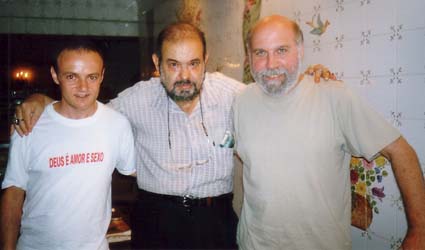
Endnotes
1 Totaro, Donato. A Meia-Noite Levarei Sua Alma (At Midnight I’ll Take your Soul, 1963), pp. 137-139, in Peter Rist, Timothy Barnard, ed., South American Cinema: A Critical Filmography, 1915–1994 (Austin, TX: University of Texas Press, 1998 [NY: Garland, 1996].




